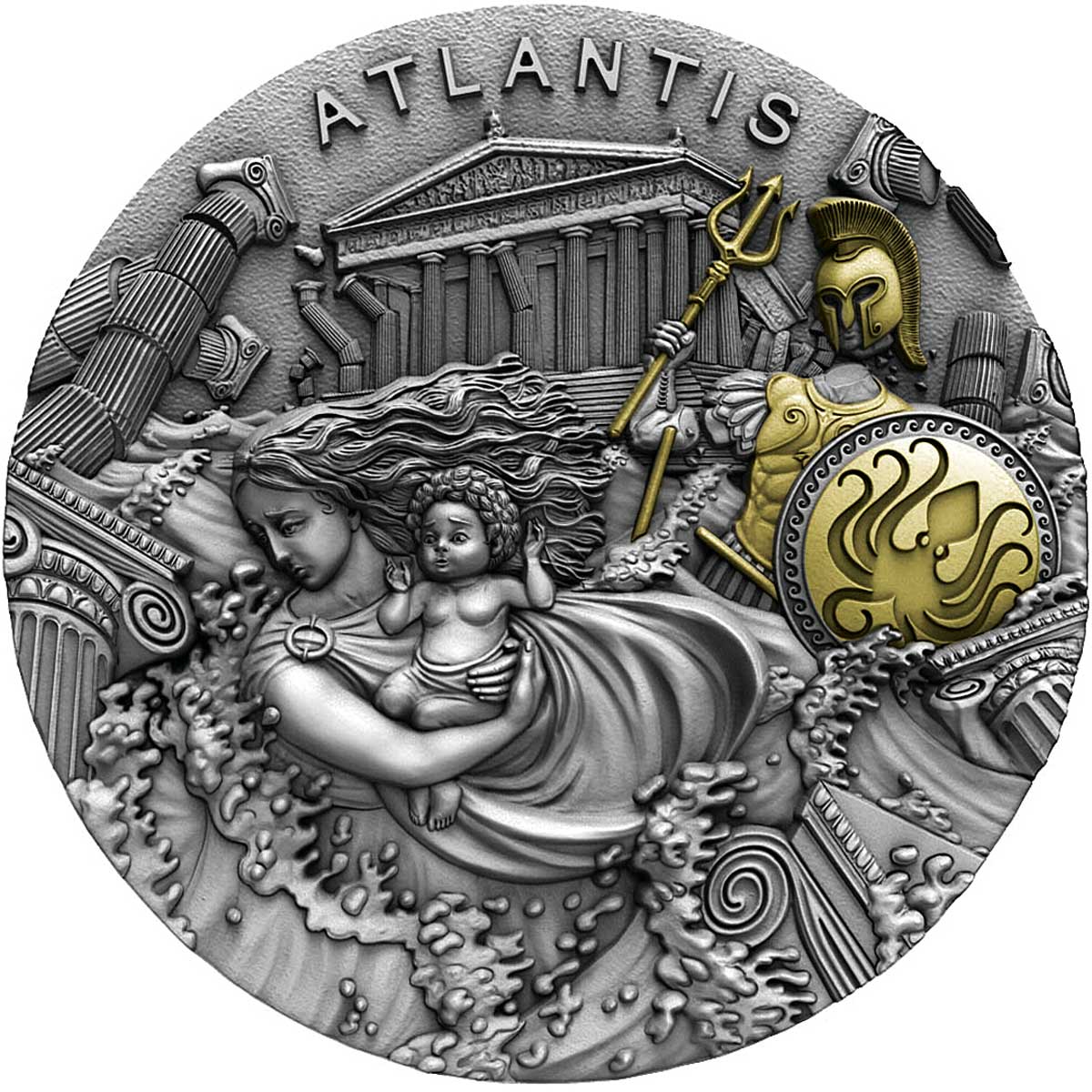Legendary Lands starts a numismatic look at mysterious civilisations with the most iconic of all, Atlantis
The latest of the Mint of Poland’s flagship format coin series to debut is ‘Legendary Lands’, a numismatic journey through some of the more mysterious and outright fabricated of the world’s ancient civilisations. There’s no better place to start than the big daddy of them all, the lost city of Atlantis.
Despite being based on a book by the legendary 3rd century B.C.Athenian writer, Plato, who himself was recounting stories from millennia before his time, the tale of Atlantis still resonates today. Hardly a year goes by without a ludicrous claimant discovering the location of the fabled sunken city, but it’s all likely nonsense, no matter how much we’d love it to be true.
The coin depicts the classic view of the end of a cultured civilisation that was destroyed by earthquake/flood because it had displeased the gods. Classic Greco-Roman architecture abounds. A gilded statue breaks apart under the tumultuous torrent – the Kraken emblazoned on the shield a great little touch. The mother and child desperately trying to escape in the foreground is the main focus and the face is kept mercifully free of excess inscriptions – just the title present. Hardly any of the coin isn’t filled with detail.
The obverse is a wonderful piece and a pleasure to look at on a Niue issue usually filled with just the effigy of QEII. The scene is of the broken city on the seabed, overgrown with corals and swarmed with shoals of fish and a pair of cetaceans. It’s a clever idea to show the aftermath of the cataclysm, although how they will continue the concept with other entries moving forward remains to be seen.
As you would expect, the 500 mintage coin is supplied boxed with a themed sleeve and a Certificate of Authenticity. The serial number is engraved into the edge of the coin. It should ship early in April.
ATLANTIS
Atlantis (Ancient Greek: Ἀτλαντὶς νῆσος, “island of Atlas”) is a fictional island mentioned within an allegory on the hubris of nations in Plato’s works Timaeus and Critias, where it represents the antagonist naval power that besieges “Ancient Athens”, the pseudo-historic embodiment of Plato’s ideal state in The Republic. In the story, Athens repels the Atlantean attack unlike any other nation of the known world, supposedly giving testament to the superiority of Plato’s concept of a state. The story concludes with Atlantis falling out of favour with the deities and submerging into the Atlantic Ocean.
Despite its minor importance in Plato’s work, the Atlantis story has had a considerable impact on literature. The allegorical aspect of Atlantis was taken up in utopian works of several Renaissance writers, such as Francis Bacon’s New Atlantis and Thomas More’s Utopia. On the other hand, nineteenth-century amateur scholars misinterpreted Plato’s narrative as historical tradition, most famously in Ignatius L. Donnelly’s Atlantis: The Antediluvian World.
Plato’s vague indications of the time of the events—more than 9,000 years before his time—and the alleged location of Atlantis—”beyond the Pillars of Hercules”—has led to much pseudoscientific speculation. As a consequence, Atlantis has become a byword for any and all supposed advanced prehistoric lost civilizations and continues to inspire contemporary fiction, from comic books to films.
While present-day philologists and classicists agree on the story’s fictional character, there is still debate on what served as its inspiration. As for instance with the story of Gyges, Plato is known to have freely borrowed some of his allegories and metaphors from older traditions. This led a number of scholars to investigate possible inspiration of Atlantis from Egyptian records of the Thera eruption, the Sea Peoples invasion, or the Trojan War. Others have rejected this chain of tradition as implausible and insist that Plato created an entirely fictional nation as his example, drawing loose inspiration from contemporary events such as the failed Athenian invasion of Sicily in 415–413 BC or the destruction of Helike in 373 BC. (WIKIPEDIA)
| SPECIFICATION | |
| DENOMINATION | $5 NZD (Niue) |
| COMPOSITION | 0.999 silver |
| WEIGHT | 62.2 grams |
| DIMENSIONS | 45.0 mm |
| FINISH | Antique |
| MODIFICATIONS | Ultra high-relief, gilding, edge number |
| MINTAGE | 500 |
| BOX / C.O.A. | Yes / Yes |






Leave A Comment